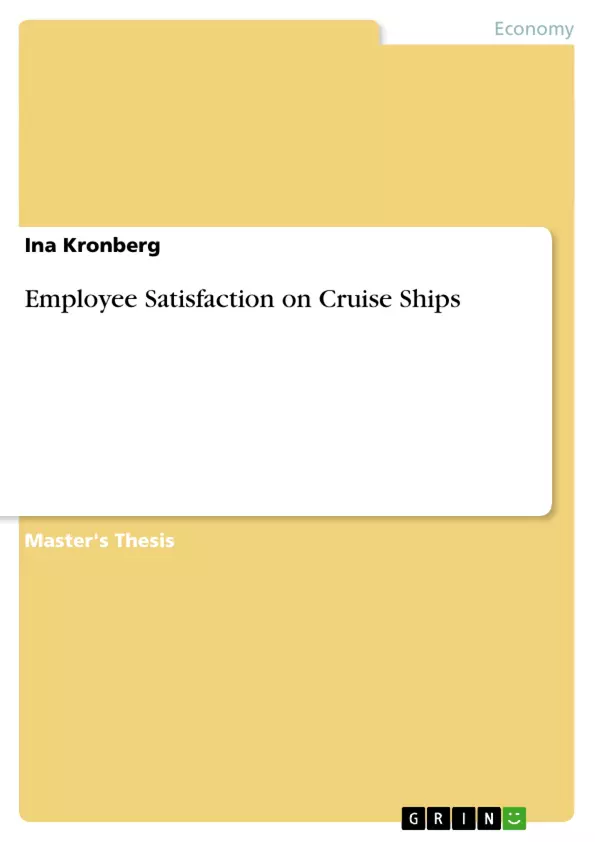The concept of job satisfaction is one of the most extensively researched area in organisational management as a consequence of its association with individual and organisational outcomes. In order to explain the concept, the study explores traditional, e.g. Maslow’s „hierarchy of needs”, and new theories of job satisfaction. Although many studies were conducted in various industries there seems to be a lack of research amongst seafarers on cruise ships. The cruise industry has been one of the fastest growing sectors within the tourism industry over the last decade and it is estimated that the industry continues to grow by 10% annually (Testa et al., 1998a). Cruise ships offer a unique work environment so that this research aims to assess job satisfaction of seafarers in relation to employee expectations and experiences, supervisor and co-worker relationships, as well as working and living conditions.
For this cross-sectional study the researcher used a quantitative research design and undertook the investigation in a non-contrived setting. The lack of an appropriate instrument to measure the above mentioned variables in such a unique and complex workplace led the researcher to develop a new scale suitable for the cruise industry. The instrument was developed by reviewing popular scales, such as, the Minnesota Job Satisfaction Questionnaire. The sample of seafarers was taken from two ships of an American cruise line operating in the luxury cruise market.
The investigation revealed that the developed instrument is a valid and reliable measure to assess job satisfaction in the cruise industry. Significant results were found throughout the study and it appeared that seafarers are generally satisfied with their job. However, on Ship B there was indication that some crew members perceived racial discrimination on board so that their satisfaction levels were below average. Thus, the results obtained are valuable for the cruise line insofar as the identified factors which cause dissatisfaction could be improved or eliminated. From a theoretical point of view the study confirmed Maslow’s conclusion that individuals proceed along the hierarchy of needs.
Inhaltsverzeichnis (Table of Contents)
- Chapter 1: Introduction
- The Meaning of Work
- Aim of Study
- Structure of Study
- Chapter 2: Job Satisfaction
- Introduction
- Job Satisfaction Defined
- Theories of Job Satisfaction
- Maslow's Hierarchy of Needs
- Criticism of Maslow's Theory
- Herzberg's Two-Factor Theory
- Criticism of Herzberg's Theory
- Antecedents of Job Satisfaction
- Outcomes of Job Satisfaction
- Summary
- Chapter 3: Theoretical Framework
- Introduction
- The Psychological Contract
- Expectations
- Where do Expectations Come From?
- Violations of the Psychological Contract
- Experiences
- The Role of the Supervisor and Leader-Member Exchange Theory
- Outcomes of Leader-Member Exchanges
- The Role of Co-Workers and Team-Member Exchange Theory
- Outcomes of Team-Member Exchanges
- Summary
- Chapter 4: The Cruise Industry
- Introduction
- The Concept and Industry Trends
- International Crews and Flags of Convenience
- Life on the Ocean Wave
- The Organisation of Cruise Ships
- Working and Living Conditions on Cruise Ships
- Length of Contract and Hours of Work
- Food and Accommodation
- Recreation Facilities
- Summary
- Chapter 5: Methodology
- Introduction
- Research Objectives
- Theoretical Framework
- Research Design
- Purpose of Study
- Type of Investigation and Study Setting
- Unit of Analysis
- Time Horizon
- Sampling Design
- Primary Data Collection Methods
- Survey Research
- Questionnaire Design
- Goodness of Measures
- Data Analysis
- Summary
- Chapter 6: Findings
- Introduction
- Data Collection
- Socio-demographic Profile of Seafarers
- Psychometric Properties of Scales
- Construct Validity of Satisfaction Scales
- Reliability of Satisfaction Scales
- Reliability of Expectation and Experience Scales
- Hypotheses Testing
- Predicting Job Satisfaction
- Standard Multiple Regression
- Hierarchical Regression
- Assessing Job Satisfaction on Ship A and Ship B
- Satisfaction Levels between Departments
- Satisfaction with Supervisor
- Satisfaction with Working and Living Conditions
- Satisfaction with Well-being Factors
- Satisfaction with Co-Workers and Job Satisfaction
- Comparison of Satisfaction Levels between Ship A and Ship B
- Satisfaction with Supervisor between Departments
- Overall Job Satisfaction Comparing Ranks
- Summary
- Quote paper
- Ina Kronberg (Author), 2003, Employee Satisfaction on Cruise Ships, Munich, GRIN Verlag, https://www.grin.com/document/136465



